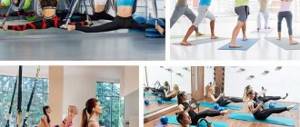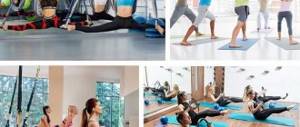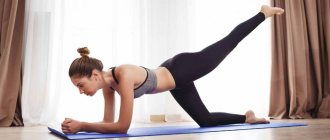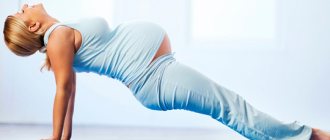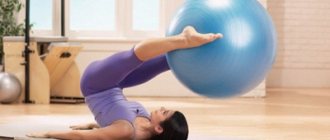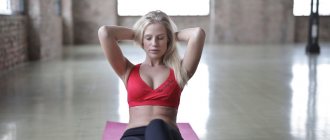In any fitness class you will see a fitball; exercises with it are common in therapeutic physical education, yoga and Pilates, and other rehabilitation areas. A significant part of Pilates programs is aimed at restoring mobility to people with musculoskeletal disorders; these are highly effective exercises with minimal loads. Fitball training meets this goal; Pilates with a fitball is also great for pregnant women.
In any fitness club you will definitely see a fitball; the ball is used in numerous fitness programs, yoga and Pilates. A significant part of Pilates programs is aimed at restoring mobility to people with musculoskeletal disorders.
Pilates with a fitball will also be useful for pregnant women and overweight people.
Tips for training with a fitball
Before moving on to the list of exercises with a fitball, let's remember how to properly exercise with a rubber ball so that the workout is effective and high-quality. We offer you 10 useful tips for training with a fitball at home or in the gym.
Features of performing exercises with a fitball:
- When performing exercises with a fitball, you should be focused on your muscles and feel their tension. Try to train not for speed, but for quality.
- Use in your workout not only exercises for your problem area, but also exercises for the whole body. To successfully lose weight, you need to work in a balanced manner on all muscle groups, and not just on the stomach or just, for example, on the hips.
- Remember that the more you inflate the fitball, the more difficult it is to perform the exercises. If you are just learning to train with the ball, do not inflate it until it is completely elastic at first.
- If you don't know how to build a workout, then use the circular principle. Take 5-6 exercises and alternate them with each other in several rounds. The second part of the article offers specific exercise programs that can be taken as a basis.
- All 50 exercises with a fitball that we offer are divided into 4 groups: for the upper body (shoulders, arms, chest), for the core (back, abdomen), for the lower body (hips and buttocks), for the whole body (working all major muscle groups).
- Exercises with a fitball are especially effective in working on the muscular corset, so even exercises with a ball for the hips and buttocks help strengthen the abdominal and back muscles as well.
- For most of the proposed exercises, you will not need any other additional equipment other than a fitball.
- If you find it difficult to repeat an exercise with a fitball (for example, due to insufficient balance), then either modify it into a more simplified version, or do not perform this exercise at all for now.
- Exercises with a fitball are an excellent way to prevent back and lower back pain.
- Read more about the benefits of a fitball, as well as how to choose the right one, in the article: Fitball for weight loss: effectiveness, features, how to choose.
Fitball for Pilates: rules of choice, advantages and features of working with the apparatus
The ball can be used not only in gyms, but also at home. The projectile will allow:
- set a moderate pace of training - no sudden movements%
- train for pregnant women and people with musculoskeletal problems;
- choose the load level;
- practice even for beginners;
- improve joint mobility and muscle strength, increase the plasticity of ligaments.
Pilates suggests moving smoothly, without sudden lunges or dynamics. To train all muscle groups, choose the right fitball. They focus on the height of the student - up to 155 cm - a ball with a diameter of 45 cm; up to 185 – 55; from 185 – 75.
A high-quality projectile is elastic, which is important to check when purchasing. This ball can withstand up to 300 kg.
The evolution of the Pilates ball
The core strength training system is named after its creator, Joseph Pilates, who developed the workout for hospital patients during World War I. After his death, in 1967, Pilates began to use a fitball, a large stabilizing ball. In the 1990s, it was first proposed to use a small Pilates ball with a diameter of approximately 18 cm to prevent back injury during certain exercises. The miniball isolates the abdominal muscles as they support the back muscles, thereby reducing the risk of injury.
How to choose a Pilates ball
of Pilates balls :
- Fitball is a large ball with a diameter of 45-90cm
- Miniball is a small ball with a diameter of 11-20 cm and weighing up to 2 kg.
When choosing a miniball, you need to look at its diameter and weight; you need the ball to fit comfortably in your hand. Fitball is most often selected based on height. Moreover, when choosing Pilates balls, we recommend looking at the material from which they are made. They come in latex, rubber and polyvinyl chloride. Each material has its pros and cons. One of the best, of course, is polyvinyl chloride. It has a soft surface, increased strength and is the least allergenic. The ball must come with a pump. It is better to store large balls inflated, unlike miniballs. It won't take much time to pump up the latter.
Benefits of doing Pilates exercises with a miniball
Research shows that if you perform traditional crunches with a Pilates ball under your lower back, your abdominal muscles will work more effectively by increasing your range of motion while providing excellent support to your back.
Now try this full Pilates mini-ball workout!
Isolation of the abdominal muscles occurs without increasing tension in the back muscles. With optimal use of such a ball, less trained participants in Pilates classes can make their program simpler, while advanced practitioners, on the contrary, can complicate their exercises with the same mini-ball.
Miniball for abdominal muscles
The crunch exercise with a gymnastic roller is aimed at strengthening the abdominal and back muscles. Miniball Pilates has its own variation of this exercise. Holding the ball increases the intensity of the Pilates load, due to which the abdominal muscles work more efficiently, and the load on the arm muscles also increases.
Lie on your back on the floor, keeping your legs together and your toes pointing straight at the ceiling. Holding the mini ball with both hands, straighten your arms above your head so that the ball rests on the floor. As you inhale, straighten your arms and raise the miniball above you. Tuck your chin in, contract your abdominal muscles, and use them to twist and sit up straight.
Sit on the floor, bend your knees, place your feet shoulder-width apart, about 60 cm from your buttocks. Place a miniball under your feet and lie on your back on the floor. Place your hands on the floor next to your hips, tighten your abdominal muscles and inhale. Push your heels off the floor and lift your butt, hips, and lower back. Exhale and stop when your knees and shoulders are in line.
Hold this position for 45 seconds while maintaining your normal breathing rhythm. This exercise will strengthen the muscles of the core, thighs and buttocks. Using a mini ball for Pilates will make it more difficult to maintain balance. Therefore, in order to maintain balance, the body is forced to connect additional muscles.
Swimming
The swimming exercise, or arm and leg raise, works the muscles of the lower back, legs, shoulders and arms. Holding a mini ball will make your upper body more challenging during this Pilates exercise.
Only add miniballs to this exercise if you can complete two sets without feeling fatigued. Holding the ball in your hands, lie on your stomach, straighten your arms above your head and place them on the floor. Squeeze and lower your shoulder blades, relax your shoulders and move them further away from your ears. Raise your head slightly, looking at the floor.
Raise your arms and legs, try to stretch them as far as possible, increasing the distance between your fingers and toes. Inhale and lift your right arm and left leg about 7-8 cm from the ground. Immediately lower and do the same with the opposite arm and leg. Continue alternating arms and legs for five seconds while inhaling and five seconds while exhaling. Perform the exercise for 30 seconds.
Miniball Pilates is ideal for those who have already achieved mastery in performing basic exercises and want to increase the load. Complex exercises will help you strengthen your muscles more effectively, so your body will gain additional strength and attractive definition. Try these exercises with a miniball and notice the pleasant sensations in your muscles!
What is “miniball”
Miniball refers to small fitness equipment. In modern fitness clubs, it is used mainly in Pilates and yoga classes, but it is also great for any other types of training, both fast and slow, here everything will depend on the imagination of the trainer.
Fitness balls are divided into two main types: mini ball (“mini ball”) small and fitball (from the English “fit” - health improvement, “ball” - ball) - large.
The classic miniball has the shape of a sphere with a diameter of 20 to 30 cm. According to the principle of operation, it resembles a fitball (read more about fitball in this article). The main difference between these two balls is their size: while the familiar fitball has large dimensions from 45 to 95 cm, can be round or oval in shape and with handles for stability, then the miniball has dimensions that are several times smaller.
The fitball is selected according to height; for comfortable training, its diameter must correspond to certain parameters of the human body. The size of the miniball is selected solely based on ease of use and the color you like.
The miniball models currently on the market are made from durable and reliable polyvinyl chloride and have an ABS (Anti-Burst System) system. In the event of a puncture or any other damage to the surface, they do not burst, but simply deflate slowly.
A standard miniball can easily withstand loads with a person weighing up to 110 kg. It has a soft, pleasant to the touch surface, however, there are models with a corrugated surface or with pimples.
Pilates is a rather complex set of exercises that require precise technique, but if you have achieved some success in it, and your usual workouts are easy for you, it’s time to experiment with small equipment. The most common and affordable small equipment in Pilates include: fitball, miniball, foam roller, isotonic ring, rubber shock absorbers, elastic bands and gliding discs. Miniball is a very affordable mini exercise machine and can be found in any fitness club; I recommend starting to expand your skills with it. By using a small Pilates ball during exercise, muscle activity is enhanced. The ball will isolate individual muscles as you focus on holding it. Pilates with a miniball helps to modify and supplement standard exercises, thereby significantly increasing the effectiveness of the workout as a whole.
Relevant products in the Online store:
Caudalie
After Sun Body Lotion
from 1,995 rub.
Clarins
Gelée Rafraîchissante Après Soleil Refreshing after-sun gel for face and body
from 1,950 rub.
Caudalie
Body scrub CABERNET
from 2,220 rub.
Clarins
Baume Corps Super Hydratant Neroli Body Balm
from 780 rub.
limited edition
All goods
Pilates reformer
Basic principles of Pilates training on machines
Pilates reformer gymnastics is:
Firstly
, strictly individual, selected exercises in a certain sequence and a general training program on Pilates machines;
Secondly
, the presence of a system of progressive resistance springs, belts and pulleys on Pilates machines allows you to perform more than 100 different exercises with adjustable load;
Third,
within one workout, exercises on Pilates machines can be performed:
- consistently using one or another Pilates equipment
- using only one Pilates machine for a given workout
Fourth
consistent and smooth execution (several times) of individually selected exercises with a “correctly aligned” and controlled body position;
Fifthly
adherence to the basic principles of Pilates: breathing technique, concentration, correct and precise execution of movements, adherence to the rules of loads and movements within the limits of one’s own comfort
Pilates on a reformer will allow you to:
- experience sensations that you have never experienced in the gym;
- strengthen muscles, not increase their volume;
- comprehensively tighten the biceps, triceps, as well as the abdominal and back muscles;
- strengthen the pelvic muscles and recover after childbirth;
- improve body balance, correct posture;
- improve the functioning of internal organs;
- during the lesson, even those muscles that you had no idea about before will be used;
Benefits of Pilates training on large equipment
- exercises on Pilates machines can be performed by any user, regardless of age and gender - Pilates for children and adults;
- Pilates training on the reformer is carried out strictly on an individual basis. The simulators are customizable, the springs are set to one of three degrees of resistance;
- on Pilates machines you can perform a huge number of exercises, limited only by the imagination and capabilities of the practitioner;
the simplicity of the exercises performed on reformer simulators ensures both the speed of their mastery and safety for the practitioners;
the training process has a beneficial effect on muscle stretching and tone (Pilates for the abs and buttocks), increases the range of mobility of the joints and spine, which is an effective prevention of osteochondrosis and arthrosis (Pilates for the spine and joints);
Effectiveness of Pilates reformer classes
- prevention and rehabilitation for diseases of the musculoskeletal system such as osteochondrosis, arthritis, arthrosis, coxarthrosis and coxarthritis, after spinal surgery and intervertebral hernias, as well as other somatic diseases of the nervous, cardiovascular, respiratory and genitourinary systems;
- a large number of exercises related to repulsion and resistance to compression improve metabolism and stabilize pathological processes inside bone tissue, ensuring the strengthening of bone tissue;
- exercises on an unstable (moving) platform - the ALLEGRO reformer contribute to the development of balance and coordination, which decrease with age. Consequently, such classes influence the biomechanics of movement and provide the correct stereotype of movement; Pilates gymnastics on reformers is the prevention of toxicosis and excess weight during pregnancy. Effective preparation of muscles, pelvic floor tissues and bone tissues for childbirth (Pilates for pregnant women). Fast recovery after childbirth;
- working for the benefit of health and longevity turns into one of the pleasures in life.
Simply put, Pilates reformer gymnastics is Pilates for the back and joints, abs and buttocks, abdomen and legs, Pilates for those who want to lose weight, Pilates for pregnant women and for restoring their figure after childbirth, Pilates for rehabilitation and prevention of a wide variety of musculoskeletal diseases. musculoskeletal system and almost all somatic diseases.
Equipment for Pilates gymnastics on a reformer
- Allegro reformer trainer
- trapeze trainer Cadillac
- springs of different complexity levels to optimize the load
- classic reformer “Pilates Plus”
- barrel with ladder “Pilates Plus”
- classic chair “Pilates Plus”
- back corrector
- boxing
- slings with loops for arms and legs
- pilates ring
- yoga belt
- block yoga (brick yoga)
- roll
- rubber shock absorber
- gymnastic ball
- stretch barrel
- unstable platform "Bosu" (hemisphere)
- gymnastic disk
To find out more about Pilates reformer training or to sign up for your first lesson, call us at +7 (495) 500-01-40.
Our experienced, certified Pilates trainers will develop personalized Pilates Reformer training programs for you.
